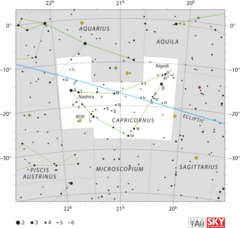Astronomy:Theta Capricorni
| Observation data Equinox J2000.0]] (ICRS) | |
|---|---|
| Constellation | Capricornus |
| Right ascension | 21h 05m 56.82783s[1] |
| Declination | −17° 13′ 58.3021″[1] |
| Apparent magnitude (V) | +4.07[2] |
| Characteristics | |
| Spectral type | A1 V[3] |
| U−B color index | +0.01[2] |
| B−V color index | −0.01[2] |
| Astrometry | |
| Radial velocity (Rv) | −10.9[4] km/s |
| Proper motion (μ) | RA: +79.33[1] mas/yr Dec.: −62.01[1] mas/yr |
| Parallax (π) | 20.11 ± 0.28[1] mas |
| Distance | 162 ± 2 ly (49.7 ± 0.7 pc) |
| Absolute magnitude (MV) | +0.60[5] |
| Details[6] | |
| Mass | 2.24 M☉ |
| Radius | 2.7[7] R☉ |
| Luminosity | 65[8] L☉ |
| Surface gravity (log g) | 4.19±0.14 cgs |
| Temperature | 10,001±340 K |
| Metallicity [Fe/H] | +0.26[5] dex |
| Rotational velocity (v sin i) | 104 km/s |
| Age | 152 Myr |
| Other designations | |
| Database references | |
| SIMBAD | data |
Theta Capricorni, Latinized from θ Capricorni, is a white-hued star in the southern constellation of Capricornus,[10] positioned 0.58° south of the ecliptic.[11] Sometimes, this star is called by the name Dorsum,[12] meaning the back (of the goat) in Latin. It can be seen with the naked eye, having an apparent visual magnitude of +4.07.[2] Based upon an annual parallax shift of 20.11 mas as seen from the Earth,[1] the star is about 162 light years from the Sun. It is drifting closer with a radial velocity of −11 km/s.[4]
This is an ordinary A-type main sequence star with a stellar classification of A1 V.[3] Radial velocity variations indicate it may be a binary star system,[13] but when the system was examined in the infrared, no companion was detected.[14] Theta Capricorni has an estimated 2.24[6] times the mass of the Sun and around 2.7[7] times the Sun's radius. It is 152 million years old and is spinning fairly rapidly with a projected rotational velocity of 104 km/s.[6] The star is radiating 65[8] times the solar luminosity from its photosphere at an effective temperature of around 10,000 K.[6]
Night viewing
The star or star system is almost eclipsed by the Sun on about 3 February, when it will figure behind the Sun's corona if there is a full solar eclipse.[15] Thus the star can be viewed the whole night, crossing the sky, in early August (in the current epoch).
Chinese name
In Chinese, 十二國 (Shíer Guó), meaning Twelve States, refers to an asterism which represents twelve ancient states in the Spring and Autumn period and the Warring States period, consisting of θ Capricorni, φ Capricorni, ι Capricorni, 38 Capricorni, 35 Capricorni, 36 Capricorni, χ Capricorni, 30 Capricorni, 33 Capricorni, ζ Capricorni, 19 Capricorni, 26 Capricorni, 27 Capricorni, 20 Capricorni, η Capricorni and 21 Capricorni.[16] Consequently, the Chinese name for θ Capricorni itself is 秦一 (Qin yī, English: the First Star of Qin), meaning that this star (together with 30 Capricorni[17]) and δ Serpentis in Right Wall of Heavenly Market Enclosure (asterism)[18] represents the state Qin (秦) (or Tsin).[19]
References
- ↑ 1.0 1.1 1.2 1.3 1.4 1.5 van Leeuwen, F. (2007), "Validation of the new Hipparcos reduction", Astronomy and Astrophysics 474 (2): 653–664, doi:10.1051/0004-6361:20078357, Bibcode: 2007A&A...474..653V.
- ↑ 2.0 2.1 2.2 2.3 Johnson, H. L. et al. (1966), "UBVRIJKL photometry of the bright stars", Communications of the Lunar and Planetary Laboratory 4 (99): 99, Bibcode: 1966CoLPL...4...99J.
- ↑ 3.0 3.1 Cowley, A. et al. (April 1969), "A study of the bright A stars. I. A catalogue of spectral classifications", Astronomical Journal 74: 375–406, doi:10.1086/110819, Bibcode: 1969AJ.....74..375C.
- ↑ 4.0 4.1 Wilson, R. E. (1953), "General Catalogue of Stellar Radial Velocities", Carnegie Institute Washington D.C. Publication (Carnegie Institution for Science), ISBN 9780598216885, Bibcode: 1953GCRV..C......0W.
- ↑ 5.0 5.1 Anderson, E.; Francis, Ch. (2012), "XHIP: An extended hipparcos compilation", Astronomy Letters 38 (5): 331, doi:10.1134/S1063773712050015, Bibcode: 2012AstL...38..331A.
- ↑ 6.0 6.1 6.2 6.3 David, Trevor J.; Hillenbrand, Lynne A. (2015), "The Ages of Early-Type Stars: Strömgren Photometric Methods Calibrated, Validated, Tested, and Applied to Hosts and Prospective Hosts of Directly Imaged Exoplanets", The Astrophysical Journal 804 (2): 146, doi:10.1088/0004-637X/804/2/146, Bibcode: 2015ApJ...804..146D.
- ↑ 7.0 7.1 Pasinetti Fracassini, L. E. et al. (February 2001), "Catalogue of Apparent Diameters and Absolute Radii of Stars (CADARS)", Astronomy and Astrophysics 367: 521–524, doi:10.1051/0004-6361:20000451, Bibcode: 2001A&A...367..521P.
- ↑ 8.0 8.1 McDonald, I. et al. (2012), "Fundamental Parameters and Infrared Excesses of Hipparcos Stars", Monthly Notices of the Royal Astronomical Society 427 (1): 343–57, doi:10.1111/j.1365-2966.2012.21873.x, Bibcode: 2012MNRAS.427..343M.
- ↑ "tet Cap -- Star", SIMBAD Astronomical Database (Centre de Données astronomiques de Strasbourg), http://simbad.u-strasbg.fr/simbad/sim-id?Ident=tet+Cap, retrieved 2017-05-15.
- ↑ Kaler, James B. (September 12, 2008), "Theta Capricorni", Stars (University of Illinois), http://stars.astro.illinois.edu/sow/thetacap.html, retrieved 2017-05-09.
- ↑ Pratt, John P. (February 10, 2016). "Zodiac Stars". John Pratt's Web Site. http://www.johnpratt.com/items/astronomy/zodiac/zodiac_stars.html.
- ↑ "Dorsum", www.constellationsofwords.com, http://www.constellationsofwords.com/stars/Dorsum.html, retrieved 2017-05-16.
- ↑ Lagrange, A.-M. et al. (February 2009), "Extrasolar planets and brown dwarfs around A-F type stars. VI. High precision RV survey of early type dwarfs with HARPS", Astronomy and Astrophysics 495 (1): 335–352, doi:10.1051/0004-6361:200810105, Bibcode: 2009A&A...495..335L.
- ↑ Ehrenreich, D. et al. (November 2010), "Deep infrared imaging of close companions to austral A- and F-type stars", Astronomy and Astrophysics 523: A73, doi:10.1051/0004-6361/201014763, Bibcode: 2010A&A...523A..73E.
- ↑ In the Sky Earth astronomy reference utility showing the ecliptic and relevant date as at J2000 - present
- ↑ (in Chinese) 中國星座神話, written by 陳久金. Published by 台灣書房出版有限公司, 2005, ISBN:978-986-7332-25-7.
- ↑ Ian Ridpath's Startales - Capricornus the Sea Goat
- ↑ "LacusCurtius • Allen's Star Names — Serpens". https://penelope.uchicago.edu/Thayer/E/Gazetteer/Topics/astronomy/_Texts/secondary/ALLSTA/Serpens*.html.
- ↑ Allen, Richard Hinckley (1963), "Capricornus", Star Names, Their Lore and Meaning, Dover, https://penelope.uchicago.edu/Thayer/E/Gazetteer/Topics/astronomy/_Texts/secondary/ALLSTA/Capricornus*.html, retrieved 2017-05-09.
 |


